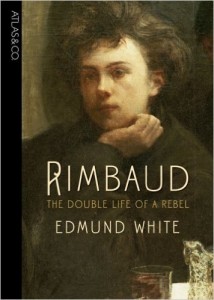 Rimbaud: The Double Life of a Rebel
Rimbaud: The Double Life of a Rebel
by Edmund White
Atlas & Co. 256 pages, $24.
IN 1873, when French poet Arthur Rimbaud was staying in London with his more famous lover Paul Verlaine, the spark-striking and strategically untruthful nineteen-year-old added two years to his age so that he could pass through a set of doors normally closed to minors. The doors in question, however, opened not on a club or an “adult” show but instead the Reading Room of the British Museum Library. The anecdote gives us a Rimbaud much more scholarly than we expect adolescents to be, but there’s more to it. One of the first book requests Rimbaud submitted to the traffic control desk was for the collected works of the Marquis de Sade, a request the Library turned down. An atheist, a pornographer, Sade figured among those authors whose works were, for Victorian reasons, not made available to the general public.
Rimbaud’s request implies an allegiance to that part of French literary tradition that is transgressive and sexually adventurous, a tradition that, besides Sade, includes François Villon, Rabelais, Pierre Choderlos de Laclos, Restif de la Bretonne, Charles Baudelaire, André Gide, and Jean Genet. From today’s vantage point it’s obvious that Rimbaud belongs to the antinomian or “immoralist” current in late 19th-century European cultural history, a trend that includes figures as distinct as Marx, Nietzsche, Wilde, and Gide. We feel sympathy with the trend when we summon its context: a world still partly feudal, intolerantly Christian, money-mad, mindlessly genteel, imperialist, tight-laced, and anti-sexual. In 1870, intellectual good manners demanded at least a token iconoclasm—a stance less defensible now, when black-market Kalashnikovs are everywhere available, the drug trade destroys whole nations, anyone can assemble a basement bomb, and unsuspecting women from Central Europe are entrapped and sold as sex-slaves to pimps in Rome and London.





